Abstract
Background
Herpes zoster is characterized by unilateral grouped vesicles along the distribution of a dermatome. A global recurrence rate as low as 0.5%∼6.2% has been reported for herpes zoster. The recurrence of herpes zoster is higher in immunocompromised patients and older patients.
Objective
The purpose of this study is to assess the frequency of herpes zoster recurrence and factors that can influence its recurrence.
Methods
From January 2005 to December 2015, 14,343 patients with herpes zoster were enrolled in this study. The patients were diagnosed at Hallym University Medical Centers and Kangwon National University Hospital in Seoul, Gyeonggi, and Gangwon. Herpes zoster recurrence and patient characteristics were surveyed by medical record review and a telephonic survey.
Results
The overall frequency of herpes zoster recurrence was 1.18%. The frequency of recurrence was higher in women than in men. It was also higher in patients aged 50∼70 years than in patients who were younger or older than this. Additionally, we assessed that the frequency of recurrence was statistically higher in patients with a compromised immune system and in patients who experienced longer lasting pain during their first episode.
Herpes zoster is a disease caused by the varicella-zoster virus of the herpes virus group. It occurs because of reactivation of the dormant virus in the nerves, such as the cranial nerve ganglia and the dorsal root ganglia, following varicella infection1. Herpes zoster is characterized by an acute vesicular rash accompanied by severe, unilateral pain along the anatomical dermatome. Although it can occur at any age, it primarily occurs in people >50 years old or in patients with a compromised immune system234. It can cause complications such as post herpetic neuralgia, motor nerve paralysis or Ramsay-Hunt syndrome567.
The global recurrence rate of herpes zoster is low, but recent studies have reported a rate ranging from 0.5% to 6.2%, which is higher than that reported earlier4589. Factors that induce the recurrence of herpes zoster include old age, the duration of pain during the first episode, diseases that weaken the immune system, and the use of immunosuppressive therapy. The recurrence rate of herpes zoster in Korean patients has been reported to be approximately 0.5%5; however, a recurrence rate of 2.3% was recently reported in a study focusing on the past 10 years9.
The current study was conducted to investigate the frequency of herpes zoster recurrence in Korean patients and to identify factors that influence the probability of recurrence by surveying patients who had herpes zoster at some point during the last 10 years and who lived in Seoul, Gyeonggi, and Gangwon. We also aimed to identify the differences in recurrence propensity according to sex, age, immunocompetence status, and duration of pain during the first episode.
To assess the frequency of herpes zoster recurrence, we surveyed a total of 14,343 inpatients and outpatients diagnosed with herpes zoster between January 2005 and December 2015 at six hospitals including five Hallym University Medical Centers (Kangnam Sacred Heart Hospital, Kangdong Sacred Heart Hospital, Hallym University Sacred Heart Hospital, Dongtan Sacred Heart Hospital, and Chuncheon Sacred Heart Hospital) and Kangwon National University Hospital. Of the total number of patients, 6,704 were surveyed in Seoul (from Kangnam Sacred Heart Hospital located in Yeongdeungpo-gu, Seoul, and Kangdong Sacred Heart Hospital located in Gangdong-gu, Seoul); 5,834 were surveyed in the Gyeonggi province (from Hallym University Sacred Heart Hospital located in Anyang, Gyeonggi, and Dongtan Sacred Heart Hospital located in Hwaseong, Gyeonggi); and 1,805 patients were surveyed in the Gangwon province (from Chuncheon Sacred Heart Hospital and Kangwon National University Hospital, both located in Chuncheon, Gangwon) (Fig. 1).
Data on herpes zoster recurrences were collected from a review of the patients' medical records and a telephonic survey. The clustered vesicles, papules, and pustules along the dermatome, and the accompanying pain were used in the clinical diagnosis in both the first and recurrent herpes zoster episodes. The clinical diagnosis was based on the patient's clinical history and findings on visual inspection by a dermatologist. In cases which were difficult to make a diagnosis or necessary to make a differential diagnosis, we reviewed the result records of Tzanck test and polymerase chain reaction test.
We assessed several affecting factors, including patient's sex, age, immunocompetence at the time of recurrence and duration of pain during the first episode. Age and duration of pain were categorized into three groups each: <50 years, 50~70 years, and ≥70 years for age; and <30 days, 30~90 days, and ≥90 days for duration of pain. To assess the effect of immunocompetence on recurrence, patients with the following characteristics were investigated: antirheumatic drug use, immunosuppressive drug use after organ transplantation, ongoing treatment for hematologic cancers such as leukemia and lymphoma, anticancer drug use, acquired immunodeficiency syndrome, diabetes mellitus and chronic kidney disease. In addition, we reviewed the interval between the first episode and the recurrence of herpes zoster, and the anatomical location of the recurrence (trigeminal, cervical, thoracic, lumbar, or sacral nerves).
Statistical analyses were performed using SPSS ver. 12.0 for Windows Statistical Package (SPSS Inc., Chicago, IL, USA), and p-value <0.05 was considered to be statistically significant. Cross-tabulation analysis by the chi-squared test was performed for each of the affecting factors and a logistic regression analysis was performed in order to assess the contribution of individual factors to the recurrence of herpes zoster.
This study was approved by the Institutional Review Board of Hallym University Medical Center (IRB no. 2016-09-002).
Total 14,343 patients were reviewed in this study, including 5,834 men (40.7%) and 8,509 women (59.3%). The patient with aged <50 years were 4,960, aged 50~70 were 6,148 and ≥70 years were 3,235. Patients that had immunocompetent status were 12,680 and immunocompromised patients were 1,663. Patients with duration of pain <30 days were 11,265, 30~90 days were 1,839 and duration ≥90 days were 1,239.
A total of 169 herpes zoster recurrences were assessed in a total of 14,343 patients and the overall frequency of recurrence was 1.18%. Of 169 patients, 134 were confirmed by medical record review and 35 were confirmed by telephonic survey. Herpes zoster recurred in 41 of the 5,834 male patients (0.70%), and in 128 of the 8,509 female patients (1.50%). Of the 4,960 patients aged <50 years, 38 patients (0.77%) experienced recurrent herpes zoster, while 94 of the 6,148 patients aged 50~70 years (1.53%), and 37 of the 3,235 patients aged ≥70 years (1.14%), experienced a recurrence. Of 12,680 immunocompetent patients 129 (1.02%) experienced a recurrence, while 40 of 1,663 immunocompromised patients (2.41%) had a recurrence. Among the immunocompromised patients who experienced recurrence, 6 patients were taking antirheumatic drugs, 3 were taking anticancer drugs and 3 were taking immunosuppressive agent due to organ transplantation. Two of forty patients were diagnosed as hematologic malignancy and 1 of 40 had acquired immune deficiency syndrome. Twenty-one patients had diabetes mellitus as an underlying disease and 4 were status of chronic kidney disease. Lastly, herpes zoster recurred in 106 of 11,265 patients (0.94%) with duration of pain <30 days, in 41 of 1,839 patients (2.23%) with duration of 30~ 90 days, and in 22 of 1,239 patients (1.78%) with duration ≥90 days (Table 1). Recurrence of herpes zoster was analyzed according to each of the patient factors by using the chi-square test. Recurrence was significantly associated with patient sex (p<0.001), immunocompetence (p <0.001), duration of pain (p<0.001), and patient age (p=0.045). Binomial logistic regression analysis showed that both sex (p<0.001, Exp(B)=2.123) and immunocompetence status (p<0.001, Exp(B)=2.402) were significantly associated with herpes zoster recurrence. This study showed statistically significant of recurrence rate between patients aged <50 years and those aged 50~70 years (p=0.014, Exp(B)=1.621), but not those aged ≥70 years (p=0.732, Exp(B)=1.085). Moreover, the recurrence of herpes zoster showed statistically significant among patients with a pain duration <30 days, 30~90 days (p<0.001, Exp(B)=2.268), and ≥90 days (p=0.019, Exp(B)=1.752) (Table 2). The frequencies of recurrence of each province were assessed as 1.93% in Seoul, 1.30% in Gyeonggi and 0.72% in Gangwon. All of provinces showed higher frequent in female and immunocompromised patients. Both in Seoul and Gyeonggi province, patients aged 50~70 years, and in Gangwon province, patients aged ≥70 years showed the hightest frequency of recurrence (Table 3). The interval between the first herpes zoster infection and the recurrence varied widely, from 1 to 31 years (mean, 5.1 years). Dermatological location of recurrent herpes zoster was divided in to trigeminal, cervical, thoracic, lumbar and sacral nerves. The recurrence was in the same dermatological location as the first episode in 52 out of 169 patients, and in a different dermatological location in 64. For the remaining 53 patients, data were unavailable or the patient did not remember the first location (Table 4).
Herpes zoster, a disease caused by the varicella-zoster virus, is characterized by clustered vesicles and pain along a dermatome1. Herpes zoster is known to occur only once in a life and the second episode of herpes zoster is rare. But recently, the recurrence incidence of herpes zoster is increasing world widely89. Researches on the disease have been conducted in many clinical laboratories and by many clinicians in Korea. Research are conducted to reveal the epidemiologic factors as well as patient age and sex, and to investigate the complications from the disease such as post-herpetic neuralgia and skin hyper pigmentations56791011. In the past, the recurrence rate of herpes zoster in Korea was reported to be approximately 0.5%5. In 2012, a study enrolled 2,210 patients with past 10 years data, reported a recurrence rate of herpes zoster was 2.31%9. However there has been no large population based investigation on the recurrence of herpes zoster in Korea. Accordingly, we aimed to assess the frequency of recurrence of herpes zoster in a larger population and to investigate the factors that can affect the recurrence. In our study, the overall frequency of recurrence was 1.18% (169 out of a total of 14,343), which was slightly lower than the most recent recurrence rate estimation in Korea (2.31%). Our finding was significant in that it was based on a large-scale study with 14,343 patients and surveyed in the areas of Seoul, Gyeonggi, and Gangwon. It was also observed in our study that the recurrence rate was higher in women, and in patients with a compromised immune system, older age, and longer duration of pain during the first episode.
It is interesting that the recurrence was significantly different between sexes and between different age groups, whereas previous research in 2012 did not identify these factors to be significant9. An increased frequency of herpes zoster recurrence in women is thought that females have more high prevalence of herpes zoster than males and be more likely to visit medical advice for their herpes zoster compared with males112.
The logistic regression analysis conducted in the present study showed that the risk of recurrence was higher in the patients aged 50~70 years old than in patients <50 years old. This difference was statistically significant (p=0.014, Exp(B)=1.621). The risk of recurrence was also higher in patients aged ≥70 years compared with that in younger patients, but the difference did not reach statistical significance (p=0.732, Exp(B)=1.085). Similar to previous reports, we observed that the recurrence of herpes zoster was statistically higher in patients with a compromised im mune system compared with that in immunocompetent patients, and we confirmed that immune status was a contributing factor in herpes zoster recurrence913. Additionally, as shown in previous research, we confirmed that duration of pain contributes to the recurrence of herpes zoster89. The frequency of recurrence was significantly higher in patients who experienced durations of pain lasting 30~90 days (p<0.001, Exp(B)=2.268) or ≥90 days (p=0.019, Exp(B)=1.752), compared with those whose duration of pain lasted <30 days. There are some limitations to our study. Some patients were diagnosed based on the laboratory testing but in some cases, recurrence of herpes zoster was determined based on patient medical records or patient memory. In this manner, inaccurate data may have been included and cases of recurrent herpes zoster may have been missed because they were neglected or misdiagnosed. In addition, although the length of the follow-up periods varied across patients, the data were analyzed without considerations for the follow-up duration. Thus the frequency of recurrence in this study cannot be regarded as recurrence rate. Finally, different patients were treated by different dermatologists, who were likely to make different diagnoses and determine different durations of pain. However, the study is significant in that it was a large-population study with over 10,000 patients enrolled (14,343 patients) and involved several provinces of central district in Korea (Seoul, Gyeonggi, and Gangwon). Therefore, it can be useful in estimating the overall recurrence of herpes zoster in Korea. Moreover, we identified factors contributing to the recurrence of herpes zoster by confirming the statistical significance of sex, age, immunocompetent status, and duration of pain. We also included more duration of pain groups in our analysis than previous studies in Korea. Hence, we expect that the present study will provide useful guidance for future research into additional factors that may be involved in the recurrence of herpes zoster.
Herpes zoster is becoming an important disease as the size of the aging population and the number of people with a compromised immune system increase along with an increased lifespan14. The current vaccine to prevent herpes zoster can be effectively used for the elderly and people with a compromised immune system, and thus, an overall change in herpes zoster epidemiology is expected with an increase in the number of people vaccinated against the disease1415. In the future, a nationwide study with a long term follow-up should be conducted as herpes zoster can occur at any age. And, factors other than those investigated in the current study may contribute to the recurrence of herpes zoster and should be examined. Furthermore, clinical reviews of aspects other than the recurrence should be conducted.
We expect that the current study will motivate many researchers to study more general factors associated with herpes zoster as well as the recurrence. In particular, we expect that the findings of this study will be useful in future research on morbidity and the recurrence of herpes zoster following the recent introduction of the herpes zoster vaccine1415.
In conclusion, the overall frequency of herpes zoster recurrence was 1.18%. The frequency of recurrence was higher in women than in men. It was also higher in patients aged 50~70 years of age than in younger or older patients. Additionally, we confirmed that the frequency of recurrence was statistically higher in patients with a compromised immune system, and in patients who had longer duration of pain during their first episode.
References
1. Oxman MN, Schmader KE. Varicella and herpes zoster. In : Goldsmith LA, Katz SI, Gilchrest BA, Paller AS, Leffell DJ, Wolff K, editors. Fitzpatrick's dermatology in general medicine. 8th ed. New York: McGraw-Hill;2012. p. 2383–2401.
2. Shin BS, Na CH, Song IG, Choi KC. A case of human immunodeficiency virus infection initially presented with disseminated herpes zoster. Ann Dermatol. 2010; 22:199–202. PMID: 20548914.

3. Keidan SE, Mainwaring D. Association of herpes zoster with leukemia and lymphoma in children. Clin Pediatr (Phila). 1965; 4:13–17. PMID: 14243915.

4. Volpi A, Gatti A, Pica F. Frequency of herpes zoster recurrence. Mayo Clin Proc. 2011; 86:586. PMID: 21628622.

5. Han ES, Choi HR, Seo SJ, Hong CK, Ro BI. A clinical study of herpes zoster during the last 10 years. Korean J Dermatol. 1994; 32:286–293.
6. Baek JO, Kim M, Roh JY, Lee JR. A case of unilateral motor paralysis of the shoulder caused by herpes zoster. Ann Dermatol. 2007; 19:91–95.

7. Jang YH, Lee JS, Kim SL, Chi SG, Lee WJ, Lee SJ, et al. Do interventional pain management procedures during the acute phase of herpes zoster prevent postherpetic neuralgia in the elderly?: a meta-analysis of randomized controlled trials. Ann Dermatol. 2015; 27:771–774. PMID: 26719654.

8. Yawn BP, Wollan PC, Kurland MJ, St Sauver JL, Saddier P. Herpes zoster recurrences more frequent than previously reported. Mayo Clin Proc. 2011; 86:88–93. PMID: 21220354.

9. Jeong SK, Kim IH. Recurrence rate of herpes zoster during the previous decade. Korean J Dermatol. 2012; 50:287–289.
10. Kim YM, Lee SY, Lee JS, Park YL, Whang KU, Cho MK, et al. Epidemiological and clinical study on herpes zoster in the province of Chungcheongnam-do (2004∼2006). Korean J Dermatol. 2008; 46:1488–1494.
11. Lee HE, Lee SY. A case of progressive cribriform and zosteriform hyperpigmentation. Korean J Dermatol. 2013; 51:291–295.
12. Thomas SL, Hall AJ. What does epidemiology tell us about risk factors for herpes zoster? Lancet Infect Dis. 2004; 4:26–33. PMID: 14720565.

13. Raza N, Iqbal P, Anwer J. Recurrence of herpes zoster in an immunocompetent adult male. J Ayub Med Coll Abbottabad. 2005; 17:80–81.
14. Oxman MN. Zoster vaccine: current status and future prospects. Clin Infect Dis. 2010; 51:197–213. PMID: 20550454.

15. Roh NK, Park YM, Kang H, Choi GS, Kim BJ, Lee YW, et al. Awareness, knowledge, and vaccine acceptability of herpes zoster in Korea: a multicenter survey of 607 patients. Ann Dermatol. 2015; 27:531–538. PMID: 26512167.
Fig. 1
The enrolled hospitals were located in several provinces of central district in Korea. A (Kangnam Sacred Heart Hospital) and B (Kangdong Sacred Heart Hospital) were located in Seoul. C (Hallym University Sacred Heart Hospital) and D (Dongtan Sacred Heart Hospital) were located in Gyeonggi province. E (Chuncheon Sacred Heart Hospital) and F (Kangwon National University Hospital) located in Chuncheon, Gangwon province.
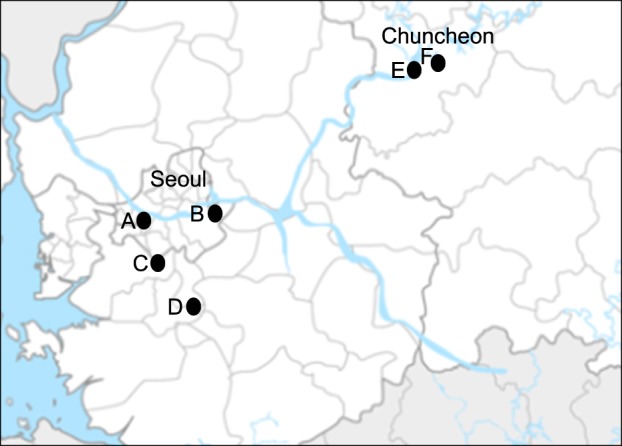
Table 1
Recurrence rate of herpes zoster, according to sex, age, immunocompetence, and duration of pain
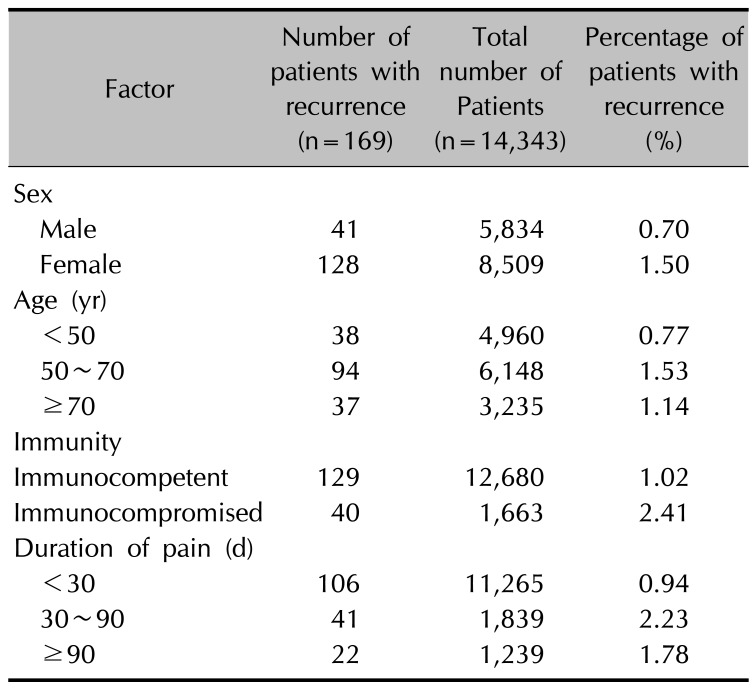
Table 2
Statistical analysis of factors influencing the recurrence of herpes zoster
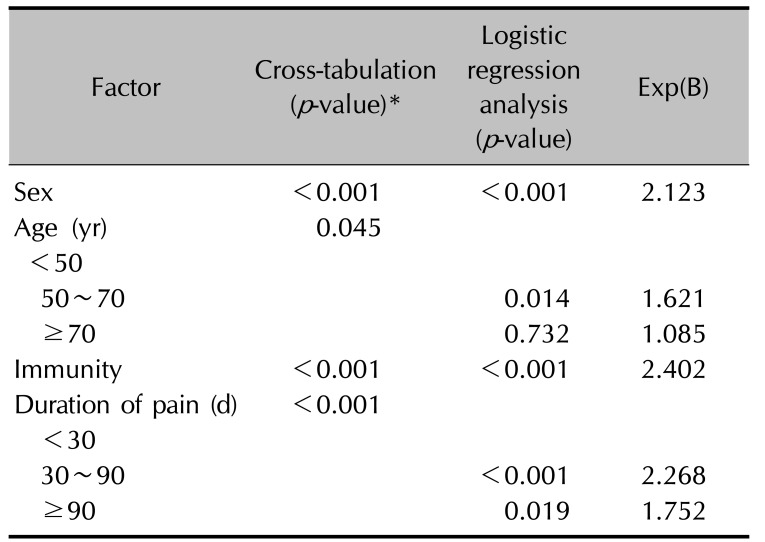
Table 3
Recurrence rate of herpes zoster, according to provinces
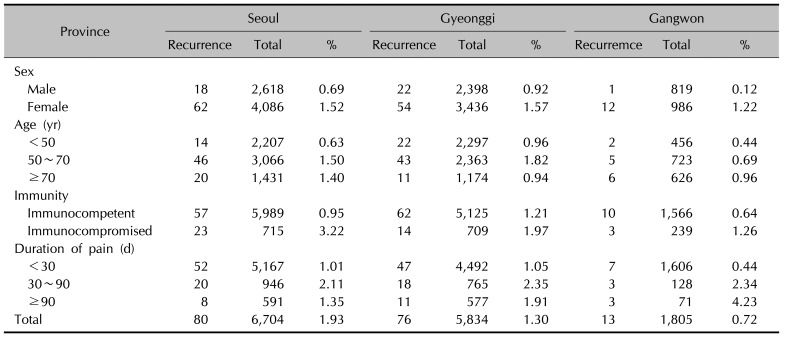
Table 4
The number of patients according to involved anatomical dermatomes
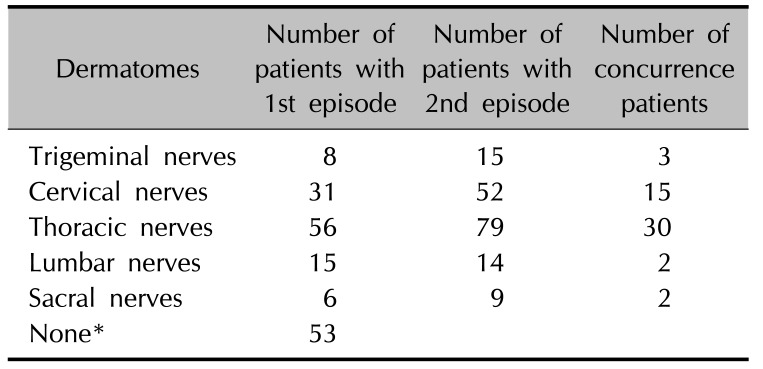




 PDF
PDF ePub
ePub Citation
Citation Print
Print


 XML Download
XML Download